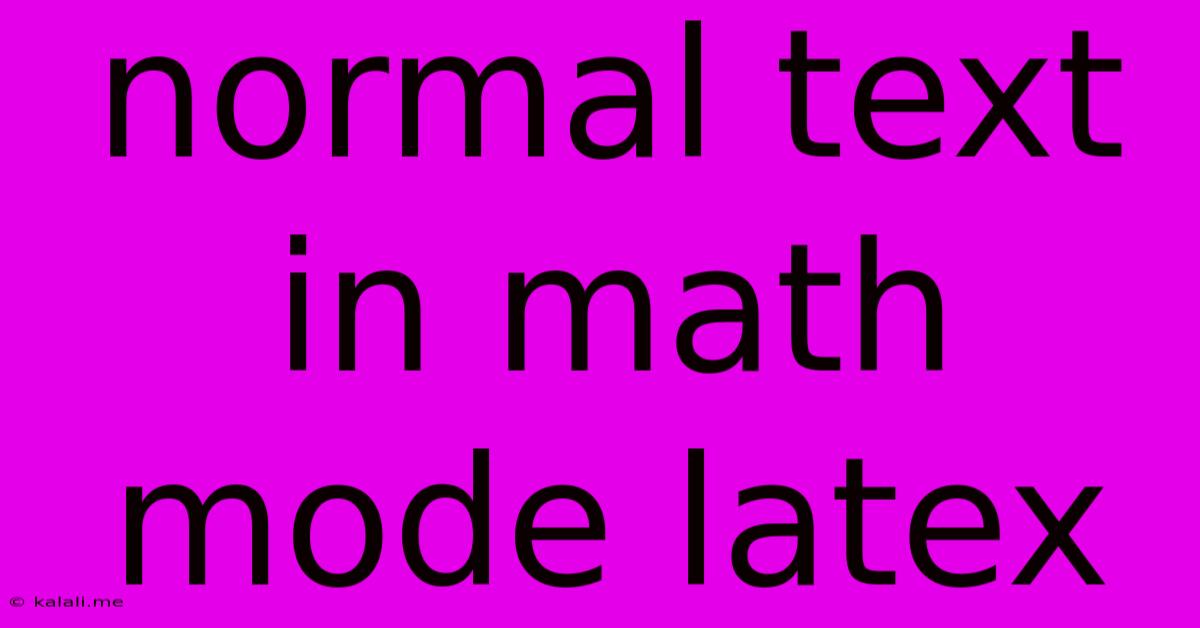Normal Text In Math Mode Latex
Kalali
May 25, 2025 · 3 min read

Table of Contents
Normal Text in Math Mode LaTeX: A Comprehensive Guide
This article provides a complete guide on how to incorporate normal text within LaTeX's math mode. Successfully integrating text into mathematical expressions enhances readability and clarity, making your documents more accessible and professional. We'll explore various methods, highlighting their advantages and disadvantages to help you choose the best approach for your specific needs.
LaTeX's math mode is powerful but can sometimes feel restrictive when you need to include descriptive text within formulas. Understanding how to seamlessly blend text and mathematics is crucial for creating elegant and understandable mathematical documents. This guide covers the essential techniques for achieving this.
Why Include Normal Text in Math Mode?
Adding normal text within mathematical expressions isn't just about aesthetics; it's about improving comprehension. Imagine a complex equation without any explanatory text – it can be daunting! By strategically inserting text, you can:
- Clarify Meaning: Label variables, explain steps in a derivation, or add units of measurement.
- Improve Readability: Break up lengthy equations and make them easier to follow.
- Enhance Presentation: Create a more professional and polished look for your mathematical documents.
Methods for Including Normal Text in Math Mode
Several commands allow for the inclusion of normal text within LaTeX's math mode. Here are the most common, along with examples:
1. \text{} command (from the amsmath package):
This is generally the preferred method. It provides the most straightforward and consistent approach. Remember to include \usepackage{amsmath} in your document's preamble.
\usepackage{amsmath}
...
\[
\text{The solution to } x^2 + 2x + 1 = 0 \text{ is } x = -1.
\]
This will render "The solution to" and "is" in the normal text font, while the mathematical equation remains in math mode.
2. \mbox{} command (older method):
While functional, \mbox{} is considered less elegant and is generally superseded by \text{}. It's mainly kept for backward compatibility.
\[
\mbox{The solution is } x = -1.
\]
The output is similar to \text{}, but it might not handle spacing as consistently.
3. $...$ for inline math within \text{}:
For cases where you need to embed a smaller mathematical expression within the normal text itself, you can use inline math mode ($...$) inside the \text{} command.
\[
\text{The roots are given by the quadratic formula: } x = \frac{-b \pm \sqrt{b^2 - 4ac}}{2a} \text{ where } a, b, c \text{ are constants.}
\]
Handling Spacing and Punctuation
Correct spacing is critical when combining text and mathematical symbols. LaTeX often handles spacing automatically, but some adjustments might be necessary. In most cases, \text{} handles spacing correctly. However, you might occasionally need to add spaces manually using \, (thin space), \; (medium space), or \quad (large space) for finer control.
Choosing the Right Method
For most situations, the \text{} command from the amsmath package offers the best balance of functionality, readability, and compatibility. Use \mbox{} only when compatibility with older LaTeX code is absolutely necessary. Nested inline math ($...$) within \text{} is beneficial for embedding small mathematical expressions directly within the textual descriptions.
By mastering these techniques, you can create LaTeX documents with clear, readable mathematical expressions that seamlessly integrate text for optimal comprehension and a professional appearance. Remember to always prioritize clarity and consistency in your mathematical writing.
Latest Posts
Latest Posts
-
How Many Cups In A Pound Of Hamburger Meat
Jul 02, 2025
-
Imagery Or Figurative Language From Romeo And Juliet
Jul 02, 2025
-
What Is A Quarter Of A Million
Jul 02, 2025
-
Which Of The Following Is True Concerning A Dao
Jul 02, 2025
-
How Long Can Catfish Live Out Of Water
Jul 02, 2025
Related Post
Thank you for visiting our website which covers about Normal Text In Math Mode Latex . We hope the information provided has been useful to you. Feel free to contact us if you have any questions or need further assistance. See you next time and don't miss to bookmark.